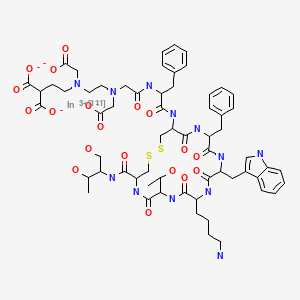Attribution Statement: LactMed is a registered trademark of the U.S. Department of Health and Human Services.
NCBI Bookshelf. A service of the National Library of Medicine, National Institutes of Health.
Drugs and Lactation Database (LactMed®) [Internet]. Bethesda (MD): National Institute of Child Health and Human Development; 2006-.
CASRN: 139096-04-1

Drug Levels and Effects
Summary of Use during Lactation
Information in this record refers to the use of indium In 111 pentetreotide as a diagnostic agent. Recommendations for use in breastfeeding mothers range from no withholding of breastfeeding necessary[1] to 60 hours after a dose of 100 to 220 MBq.[2,3]
In some cases, imaging with indium In 111 pentetreotide is followed shortly by a therapy (peptide receptor radiotherapy; PRRT) that uses yttrium 90 or lutetium 177 compounds to selectively irradiate tumors. These agents may pose additional radiation risk to the nursing infant.[1]
Mothers concerned about the level of radioactivity in their milk could ask to have it tested at a nuclear medicine facility at their hospital. When the radioactivity is at a safe level, she may resume breastfeeding. A method for measuring milk radioactivity and determining the time when a mother can safely resume breastfeeding has been published.[4]
Drug Levels
Indium 111 decays by electron capture with 173 keV and 245 keV gamma emissions and a physical half-life of 2.8 days.[5] The maximum effective half-life of indium In 111 pentetreotide is 10 hours.[3]
Effects in Breastfed Infants
Relevant published information was not found as of the revision date.
Effects on Lactation and Breastmilk
Relevant published information was not found as of the revision date.
References
- 1.
- Balon HR, Brown TL, Goldsmith SJ, et al. The SNM practice guideline for somatostatin receptor scintigraphy 2.0. J Nucl Med Technol 2011;39:317-24. [PubMed: 22068564]
- 2.
- International Atomic Energy Agency. Radiation Protection and Safety in Medical Uses of Ionizing Radiation, IAEA Safety Standards Series No. SSG-46, IAEA, Vienna. 2018. https://www
.iaea.org /publications/11102/radiation-protection-and-safety-in-medical-uses-of-ionizing-radiation - 3.
- ARSAC notes for guidance: Good clinical practice in nuclear medicine. Notes for guidance on the clinical administration of radiopharmaceuticals and use of sealed radioactive sources. 2020. https://www
.gov.uk/government /publications /arsac-notes-for-guidance [PubMed: 10732169] - 4.
- Stabin MG, Breitz HB. Breast milk excretion of radiopharmaceuticals: Mechanisms, findings, and radiation dosimetry. J Nucl Med 2000;41:863-73. [PubMed: 10809203]
- 5.
- Dilsizian V, Metter D, Palestro C, Zanzonico P. Advisory Committee on Medical Uses of Isotopes (ACMUI) Sub-Committee on Nursing Mother Guidelines for the Medical Administration of Radioactive Material. Final report submitted: January 31, 2019. 2019. https://www
.nrc.gov/docs /ML1903/ML19038A498.pdf
Substance Identification
Substance Name
Indium In 111 Pentetreotide
CAS Registry Number
139096-04-1
Drug Class
Breast Feeding
Milk, Human
Radiopharmaceuticals
Indium Radioisotopes
Diagnostic Agents
Disclaimer: Information presented in this database is not meant as a substitute for professional judgment. You should consult your healthcare provider for breastfeeding advice related to your particular situation. The U.S. government does not warrant or assume any liability or responsibility for the accuracy or completeness of the information on this Site.
- User and Medical Advice Disclaimer
- Drugs and Lactation Database (LactMed) - Record Format
- LactMed - Database Creation and Peer Review Process
- Fact Sheet. Drugs and Lactation Database (LactMed)
- Drugs and Lactation Database (LactMed) - Glossary
- LactMed Selected References
- Drugs and Lactation Database (LactMed) - About Dietary Supplements
- Breastfeeding Links
- PubChem SubstanceRelated PubChem Substances
- PubMedLinks to PubMed
- Review Octreotide.[Drugs and Lactation Database (...]Review Octreotide.. Drugs and Lactation Database (LactMed®). 2006
- Review Technetium Tc 99m Pentetate.[Drugs and Lactation Database (...]Review Technetium Tc 99m Pentetate.. Drugs and Lactation Database (LactMed®). 2006
- Review Flutemetamol F 18.[Drugs and Lactation Database (...]Review Flutemetamol F 18.. Drugs and Lactation Database (LactMed®). 2006
- Review Technetium Tc 99m Mertiatide.[Drugs and Lactation Database (...]Review Technetium Tc 99m Mertiatide.. Drugs and Lactation Database (LactMed®). 2006
- Review Chromium Cr 51 Edetate.[Drugs and Lactation Database (...]Review Chromium Cr 51 Edetate.. Drugs and Lactation Database (LactMed®). 2006
- Indium In 111 Pentetreotide - Drugs and Lactation Database (LactMed®)Indium In 111 Pentetreotide - Drugs and Lactation Database (LactMed®)
Your browsing activity is empty.
Activity recording is turned off.
See more...
